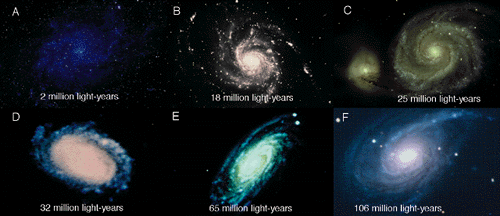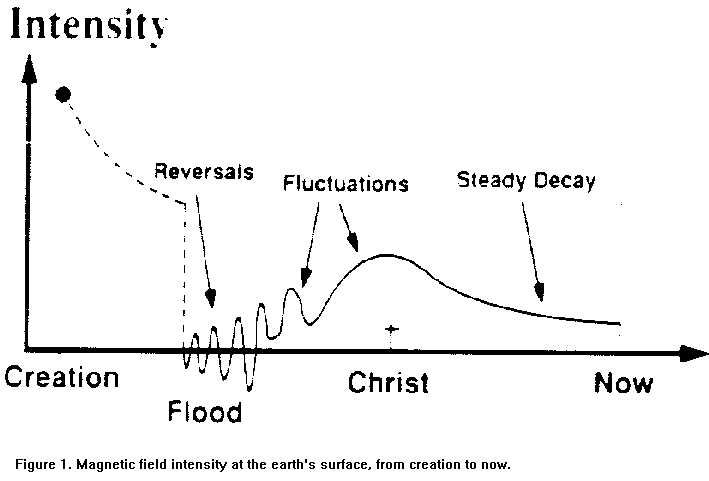|
|
|
|
§1 The
philosophy of evolution is "the present is the key to the past."
This credo is called uniformitarianism.
In practice, this means that evolutionists
believe that ancient processes occurred at the same rate they do today.
In keeping with this philosophy, it is believed that the present locally
measured speed of light (186,000 miles/second) is valid for ancient dates,
and that the present atomic processes occured at the same rate both then
and now. Skip discussion of philosophy and science.
This philosophy is questioned in II Peter:

This
leaves us with the Setterfield hypothesis. See http://www.best.com/~dolphin/cdkgal.html
for a mathematical analysis of historical measurements of the speed of
light. Setterfield's critics are many, but the hypothesis can be
neither refuted on biblical or scientific grounds. Even Humphreys
admits that CDK, "C" decay, is a possibility. The theory also requires
other fundamental atomic constants to change with time, affecting such
things as radioactive decay rates. It is important to note that more
than one curve can be fit to the measurement data, and if necessary the
velocity of light can be kept nearly constant all the way back to the flood,
or just prior to it if necessary.
Evolutionary critics are going to howl at the last
sentence in the previous paragraph. They will say that we introduce
assumptions into our theory such that it removes it from the realm of testability.
This is hardly the case. Evolutionists introduce assumptions into
their theories to accomodate the facts, so why shouldn't we. Divine
revelation is just as much a fact as empirical science.
We know that radiocarbon (C14) dating is more or less valid back to the
time of the flood (2480 b.c.e., 4477 B.P.), and that it has been calibrated
by dendrochronology back to the same time period (The oldest bristlecone
pine, "Methusela," is supposed to be 4600 years old [allow 123 years,
viz 2.7%] for double growth rings). Therefore, 90% of CDK must have
occured prior to that time. In fact the deviation of C14 from dendrochronology
indicates a greater production of C14 in the past, because a C14
1800 b.c.e. date translates into a real date of 2050 b.c.e., and a 2580
b.c.e. C14 date translates into a 3050 b.c.e. real date. Therefore,
the uncalibrated C14 date is too young by 250, and 470 years respectively.
(cf. G.W. Pearson, "High Precision 14C Measurement of Irish Oaks to Show
the Natural 14C Variation from AD 1840 to 5210 BC" in Radiocarbon 28:2B
(1986), pp. 911-34 < David M. Rohl, "Pharoahs and Kings: A Biblical
Quest," pg. 387).
Hugh Ross, in A New Look At An Old Earth, claims that "carbon-14
dates for 4000 year old wood turn out to be about 500 years too young"
(pg. 62). He does not document his claim, but promises to exlain
it in the the next chapter. In the next chapter he claims, "What
had previously been measured and thought to be a mere 6000 years old, was
now known to be about 7000 years old" (pg. 93). Again
the documentation is weak. But note Ross' conclusion on pg. 62, "This
observed fact refutes the Norman-Setterfield theory of light
speed decay" (emphasis original). Even if Ross' high deviations for
C14 is correct, (I prefer to side with Pearson and Rohl), it proves no
such thing. All it may prove is that C14 levels were higher then
than now, or that most CDK was well before the flood. The point is
that Ross has invoked the claims of empirical science (fact vs. theory)
to put down his opponents. We must not let Ross uniformitarian assumptions
about C14 equilibrium in the atmosphere mislead us. The fact is that
C14 levels have not been uniform. Can the fact that C14 levels were
higher than expected be argued in our favor? The answer is yes!
Dr. Russell Humphrey's has shown that the earth's magnetic field went through
a period of instability at the time of the flood [IMPACT No. 242, THE EARTH'S
MAGNETIC FIELD IS YOUNG, by Russell Humphreys, Ph.D.]. He includes
the below cited diagram:

Therefore, we may expect the occurance of C14 in the Atmosphere to have
been progressively higher from the flood until the time of Yeshua, because
the magnetic field sheilded earth less from neutrons which produce radiocarbon.
Uncalibrated C14 dates for the period would range from much too young to
a little too young between the flood and the first century. An this
is exactly what we find by comparing C14 with dendrochronology. We
know what the past magnetic field intensity was from archaeomagnetic research,
i.e. the study of magnetic remanants of old pottery and brick.
Now if the actual rate of C14 decay was slowing (as proposed by Setterfield)
then we would expect the C14 curve to register dates that were too old
(if there was no change in the quantity of C14 in the atmosphere, i.e.
it was in a state of equilibrium). But since we have just shown
that C14 was not in equilibrium, because of the increasing magnetic intensity,
then it follows that CDK would be masked, and that we would not detect
anomalously old C14 dates. And in fact we cannot tell how much of
the deviation from dendrochronology is due to possible change in the decay
rate, and how much is due to change in atmospheric levels. All calibration
with tree rings tells us is the total deviation.
The moral of the story is that the "uniformitarian principle" is only a
relative guide to change with time. As soon as we introduce catastrophe,
then all bets are off. It is a good place to start, but it must be
abondoned as soon as we know that a catastropohe intervened, e.g. the flood.
And in this case, we see that the catastrophic fluctations of the magnetic
field actualy explain the relation between C14 and dendrochronology.
It also shows that the calibration curve cannot be argued against CDK (e.g.
Ross' argument).
Tree Ring sequences prior to 4000 B.P. are on very shaky theoretical ground.
But I shall discuss this elsewhere.
§2 Actually, the
speed of light is not the absolute speed limit of the universe. Gravity
is faster, much faster:
" We
might as well start with gravity. Suppose the Sun were to disappear "poof."
How long will it take the Earth to notice? "About eight minutes," someone
yells from the audience, for that is how long it takes light to reach us
from the Sun. But what about the force of gravity holding us in orbit?
"Same thing!" comes the cry. "The Earth won't fly off on a tangent
until eight minutes after the Sun disappears."
"
But this is wrong. Go ahead, look it up - find the equations we use
to calculate orbits, even for items as far away as Pluto, where it takes
sunlight 5 hours to reach. There is no light-speed delay built into the
equations. "Ah, but that's just because even a five-hour delay is trivial
for something as big as the Solar System." Uh uh. Try running a computer
simulation assuming a light-speed delay on gravitational force. Know what
happens? the Solar System falls apart. In fact, about 200 years ago, Laplace
calculated that the maximum propagation delay allowable to gravity would
require a speed of something like ten million times the speed of light.
With modern measurements, we can now set the limit at about ten billion
times c.
"But,
Einstein showed that spacetime is curved, you might say. The planets follow
geodesics in spacetime, so what is really happening is that the planet
isn't being attracted by the Sun so much as it's following a deformation
set up by the Sun. But, the Sun is moving. That curvature of space due
to the Sun is constantly moving with the Sun - so for Pluto to know how
to orbit, the Sun is somehow going to have to properly distort the bit
of space that represents the relative positions of Pluto and the Sun as
they move five hours from now. To do that, you would still have to
invoke something moving at 10 billion c. It would be better to look at
direct observational evidence. Because of the light-speed delay of the
light leaving the surface of the sun, the radial rays that strike the surface
of the Earth arrive a tad bit bent. This is called aberration and amounts
to about 20 arc seconds. Now, if gravity were mediated by gravitons traveling
at light speed, you would expect to find the gravitational force vector
pointing from the Earth to the Sun to deviate by 20 arc seconds from the
true geometric position of the Sun. This forces vector can be measured
by radar ranging to other planets. As best we can measure, the deviation
is zero.
"
If you are wondering from where I get this stuff, I'd like to point you
in the direction of "Dark Matter, Missing Planets, & New Comets"
by Tom Van Flandern. Tom used to direct the Celestial Mechanics Branch
of the Nautical Almanac Office of the US Navel Observatory."
Above quote from: Jeffery D. Kooistra "Paradigm
Shifty Things" Analog magazine June 1997. [http://www.skeptic.com/oldboard/messages/1843.html].
[I have ordered Van Flandern's book through Barnes and Noble, so hopefully
I will have more on this later.]
§3 So, if the force
of gravity acts at >> 10,000,000,000 x 186,000 miles/second (>>10x109c),
then 20 billion light years would become < 2 light years as far as gravity
is concerned! How does one body know that there is a nearby mass
which it must orbit according to the laws of gravity? Somehow a "message,"
or force of some type acts between the two at >>> speed of light.
§4 Gravity is not the
only thing that is faster than the speed of light:
A strange quantum effect also causes
light, in certain situations, to slightly exceed the
normal speed of light. [See Julian
Brown, "Faster Than the Speed of Light," New Scientist,
1 April 1995, pp. 26-29. This has
also been reported in the popular press. See Sharon
Begley, "Faster Than What?," Newsweek,
19 June 1995, pp. 67-69.]
From pg. 161, FAQ, "In the Beginning." [
http://www.creationscience.com/onlinebook/faq/cdk.shtml
].